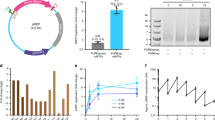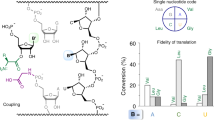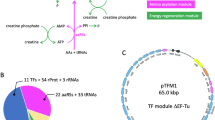Abstract
KNOWLEDGE of the mechanism of cellular protein synthesis has been advancing rapidly with the aid of the ultra-violet and electron microscopes. Nucleic acids show characteristic high absorption maxima at 260 mμ, due to the purine and pyrimidine constituents which distinguish them from other substances in biological material. By using the quartz microscope with monochromatic ultra-violet light, information has been obtained about the role of nucleic acid in cell division1 and the nucleoprotein nature of the chromosome and gene2,3. Indirect evidence for the latter has been obtained by ultraviolet irradiation of germinal tissue, when high efficiencies of mutation have been observed at 260 mμ4. Viruses also appear to be nucleo-proteins.
This is a preview of subscription content, access via your institution
Access options
Subscribe to this journal
Receive 51 print issues and online access
$199.00 per year
only $3.90 per issue
Buy this article
- Purchase on Springer Link
- Instant access to full article PDF
Prices may be subject to local taxes which are calculated during checkout
Similar content being viewed by others
References
Caspersson, T., Skand. Arch. Physiol., 73, Suppl. 8 (1936).
Schultz, J., Cold Spring Harbor Symposia Quant. Biol., 9, 55 (1941).
Gulick, A., Bot. Rev., 7, 433 (1941).
Hollaender, A., and Emmons, C. W., Cold Spring Harbor Symposia Quant. Biol., 9, 179 (1941).
Claude, A., Science, 91, 77 (1940).
Taylor, A. R., Sharpe, D. G., Beard, D., and Beard, J. W., J. Infect. Dis., 72, 31 (1943).
Hoagland, C. L., Lavin, G. L., Smadel, J. E., and Rivers, T. M., J. Exp. Med., 72, 139 (1940).
Elford, W. J., Trans. Farad. Soc., 33, 1094 (1937).
Hoagland, C. L., Ward, S. M., Smadel, J. E., and Rivers, T. M., J. Exp. Med., 74, 133 (1941).
Green, R. H., Anderson, T. F., and Smadel, J. E., J. Exp. Med., 75, 651 (1942).
Luria, S. E., and Anderson, T. F., Proc. U.S. Nat. Acad. Sci., 28, 127 (1942).
Bernal, J. D., and Fankuchen, I., J. Gen. Physiol., 25, 147 (1941).
Theiler, M., and Smith, H. H., J. Exp. Med., 65, 787 (1936).
Knight, C. A., and Stanley, W. M., J. Biol. Chem., 141, 39 (1941).
Ross, A. F., J. Biol. Chem., 143, 685 (1942).
Miller, G. L., and Stanley, W. M., J. Biol. Chem., 141, 905 (1941).
21st Ann. Rep. Brit. Emp. Cancer Campaign, 62 (1944).
Stedman, E., and Stedman, E., Nature, 152, 267 (1943).
Dounce, A. L., J. Biol. Chem., 147, 685 (1943).
Schoenheimer, R., "The Dynamic State of Body Constituents" (Cambridge, Mass., 1942), 25–65.
Rights and permissions
About this article
Cite this article
DIXON, T. Autosynthetic Molecules. Nature 155, 596–598 (1945). https://doi.org/10.1038/155596a0
Issue Date:
DOI: https://doi.org/10.1038/155596a0
Comments
By submitting a comment you agree to abide by our Terms and Community Guidelines. If you find something abusive or that does not comply with our terms or guidelines please flag it as inappropriate.



